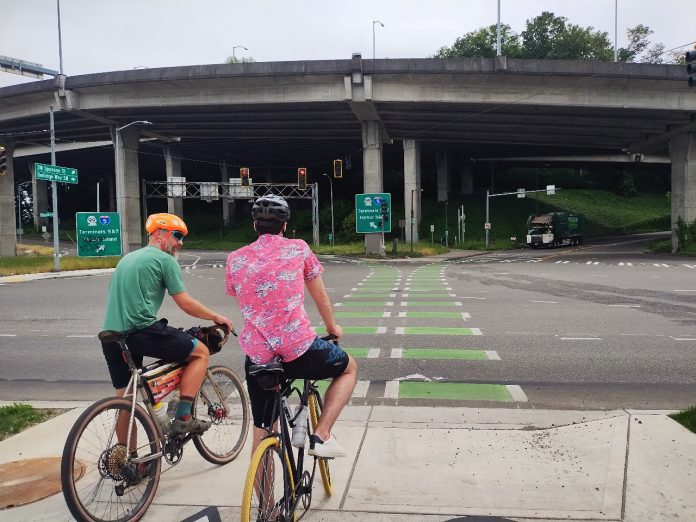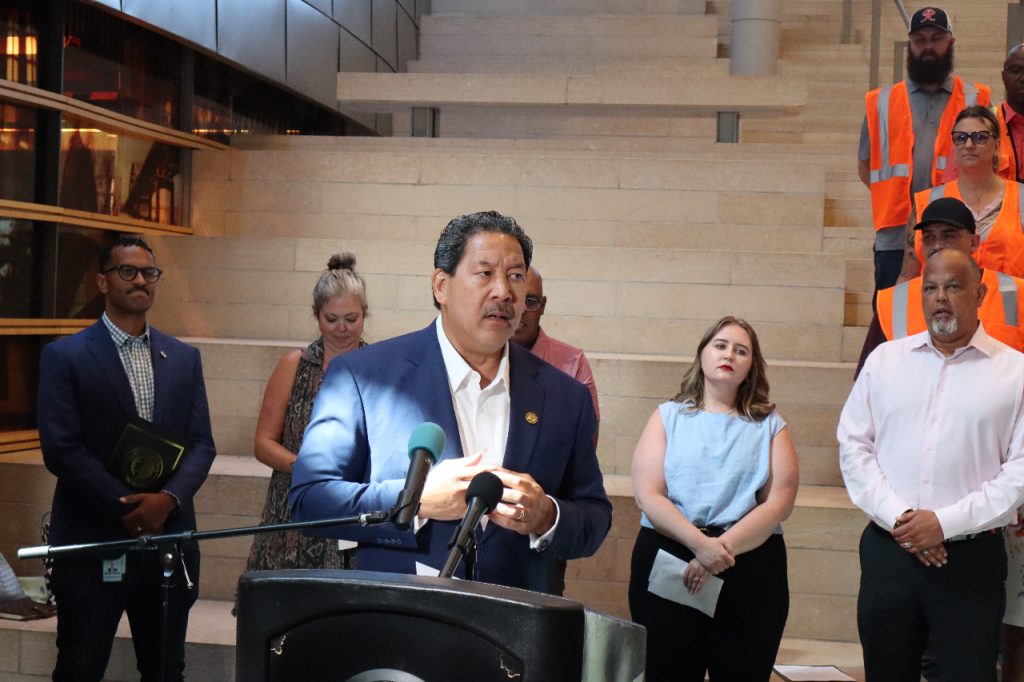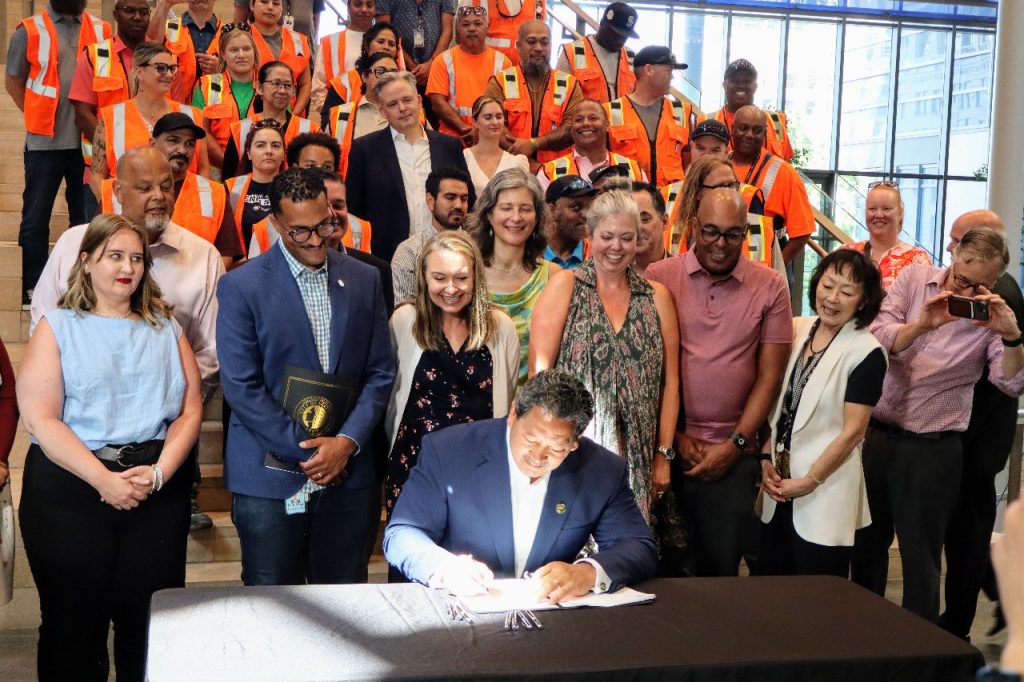
On Tuesday, the Seattle City Council unanimously approved an ordinance sending an eight-year transportation levy renewal to the November general election ballot. Adjusted for inflation, the $1.55 billion property tax measure represents an increase of around 30% compared to $930 million Levy to Move Seattle, passed in 2015 and expiring at year’s end. Under this plan, a homeowner with a median-valued house would pay $21 more per month, or $252 per year, compared to now.
The new levy includes few signature, big-ticket projects, unlike the Move Seattle Levy, which included the John Lewis Memorial Pedestrian Bridge in Northgate, the Lander Street Bridge in SoDo, an overhaul of Madison Street via the RapidRide G Line, and other splashy items. Instead, the package focuses transportation spending toward the city’s significant infrastructure maintenance backlog, which has continued to grow during the Move Seattle era, while leaving some of the decisions around how to tackle major unfunded infrastructure projects on the city’s books for another year or another decade.
In a city hall signing ceremony Wednesday morning, Mayor Bruce Harrell framed this levy as representing an all-of-the-above approach to transportation in Seattle.
“Some people have choices of how they get around, and some people do not,” Harrell said. “Our levy was designed to meet Seattle’s diverse community neighborhoods, and understand that we are living, fortunately, in a world where we have different modes of travel, and we want input from all communities and neighborhoods.”

Rob Saka, chair of the city council’s transportation committee who shepherded the bill toward yesterday’s vote, echoed that theme as well: “We need to move beyond those stages where we’re pitting one mode against another mode and one person’s choice against another person’s choice. This transportation package isn’t about the Balkanization of our roads, or our people, or our choices. It’s about all of us coming together, as evidenced here today.”
Notably, city leaders were joined by representatives of the Seattle Metropolitan Chamber of Commerce, MLK Labor Council, and Cascade Bicycle Club, but not from Seattle Neighborhood Greenways, Disability Rights Washington, or most of the other groups that had pushed for the city to go big when it comes to transportation spending — and who helped campaign for Move Seattle in 2015.
Transportation Choices Coalition (TCC), which spearheaded the Move Seattle campaign, announced the start of the campaign to pass the levy renewal shortly after the signing. “The campaign to support the levy, Keep Seattle Moving, has launched,” TCC wrote. “It will mobilize a coalition of businesses, labor, advocacy organizations, and Seattle voters to get the levy passed in November.”
The group’s press release touted “$160.5 million to Vision Zero, Safe Routes to School, and neighborhood safety projects; $151 million to improve transit corridors and connections; and $133.5 million for bicycle safety” as wins for safe streets advocates.
“No matter who you are, this levy will make it safer and easier for you to get around Seattle,” said Kirk Hovenkotter, TCC’s executive director, in a statement. “Voters will soon have the opportunity to make a generational investment in our city’s transportation future.”
Final amendments
During the City Council’s long deliberative process, which began in early May, most of the attention was focused on a small group of amendments highlighted by a push to increase funding for new sidewalks, seeking to address the significant number of gaps in the pedestrian network. Additionally, amendments funded freight improvements requested by business groups and the broadly popular Safe Routes to Schools program. Revisions also added $15 million for downtown activation and upgrades along Third Avenue, $8 million for “low pollution neighborhoods,” and $3 million for structural repairs to Pioneer Square streets.
A last minute amendment by Councilmember Tammy Morales sought to increase the total levy amount by $150 million, but was rejected by her colleagues over sticker shock concerns and deference to property owners. While the council was on board with increasing the total amount proposed by Mayor Harrell by a more incremental $100 million, or $12.5 million a year, they clearly did not want to stray too far from the initial package that Harrell put forward, especially without the blessing of the chamber of commerce, which opposed Morales’s amendment.
One final amendment was approved Tuesday. Put forward by Councilmember Dan Strauss and approved 6-3, it will allocate $20 million to building a bike trail along NW Market Street and Leary Way NW, completing the Missing Link of the Burke-Gilman trail in a way that apparently appeases industrial business owners, who have been blocking a planned trail along Shilshole Avenue NW for decades. That funding was diverted from arterial road maintenance, money that had been set aside to match for outside grant opportunities. Strauss’s gambit had originally failed in committee, along with a plan to divert sidewalk funding to an overhaul of Ballard Avenue’s cafe street.

While there are fewer detailed project lists than voters saw nine years ago with Move Seattle, the guardrails around transportation spending are actually more restrictive. Move Seattle saw three big “buckets” of spending priorities — safe routes, “congestion relief,” and maintenance, and only those overarching categories had their spending levels set by the ordinance the voters ultimately approved. The Seattle Department of Transportation (SDOT), in coordination with the Mayor’s Office, could move funding around as long as they did not change those overarching totals by more than 10% and City leaders checked in with the levy’s oversight board.
This levy goes further and sets spending levels for each individual category of spending. For example, the measure sets aside $66.5 million to be spent on People Streets and Public Spaces, and if SDOT can’t spend that amount — outside of a 10% margin — the city council will have to approve a change by a supermajority vote of at least seven of nine councilmembers. Other stipulations include at least $32 million for electric vehicle charging infrastructure, $111 million for new sidewalks, and $34 million for repair of existing sidewalks.
The transportation levy is a huge piece of Seattle’s budget; Move Seattle funds about 30% of SDOT’s budget. As a result, the ordinance commitments approved this week are likely to be the north star for city transportation investments through 2032. Those commitments are as follows:
“Back to basics” maintenance projects
- 15 corridor-wide repaving projects
- Pavement spot repair projects at 400 locations
- Repainting of 3,600 crosswalks
- 34,000 spot repairs to sidewalks
- Contributions for at least 10,000 ADA-accessible curb ramps
- Funding for city’s first preventative bridge maintenance program
- Planning work for replacement of the north segment of the Elliott Bay seawall and five other bridge structures: the 1st Ave S and 4th Ave S rail bridges in SoDo, the W Dravus Street rail bridge, the NE 45th Street viaduct, and the Magnolia Bridge.
Safety-focused investments
- 12 corridor-wide safety redesigns
- “Responsive safety projects” at 70 high-collision locations
- Traffic calming measures implemented on 50 corridors citywide
- Contributions to at least 70 projects that “improve safety and fund safety education programs” at schools
- 10 new traffic signals
- A $30 million contribution to a full revamp of Seattle’s most dangerous state highway, Aurora Avenue N, to match a planned $50 million investment from the state legislature
- 350 blocks of new sidewalks, with at least 250 required to be completed or under construction by 2029
Transit projects
- 160 individual projects to improve bus reliability, access, equity, and safety, with a focus on “performance pinch points affecting multiple routes”
- Corridor-wide improvements to Rainier Avenue S (RapidRide R), Beacon Avenue S, Aurora Avenue N, and Denny Way/E Olive Way.
- $9 million for transit rider security programs, either city-implemented or those that have been created by King County Metro or Sound Transit
- Light rail access improvements, including along N 130th Street, S Henderson Street, and at Judkins Park Station.
Seattle officials have eschewed the broad “RapidRide+” bus rapid transit promises of the Move Seattle Levy, which didn’t pan out so well due to a number of unforeseen obstacles, including a transit-averse Trump administration and a global pandemic. While Move Seattle campaign materials promised the addition of seven RapidRide lines by 2024, only one — the H Line — has been delivered thus far, with the long-delayed G Line about to finally open on September 14. Beyond the delays, three RapidRide lines pledged in Move Seattle were fully downgraded from RapidRide status, and it’s fallen upon the new levy to deliver the earlier promises for the R Line, upgrading Route 7.
The more cautious approach may be warranted given the overpromising of the earlier levy, but the lack of well-defined signature projects could also make it harder to inspire enthusiasm among transit advocates.
Now that the ordinance is on its way to King County Elections, the work will be turned over to an independent campaign to bolster public support for the levy. If past performance is any indication, those campaigners will face a favorable environment. Most recent levies in Seattle have passed by healthy margins, and the Move Seattle levy was approved in 2015 by 17 points, despite a concerted opposition effort, which seems unlikely to materialize this year.
Multiple recent polls have shown the transportation levy to be well above water with Seattle voters, even if a larger package had been put forward.
Ryan Packer has been writing for The Urbanist since 2015, and currently reports full-time as Contributing Editor. Their beats are transportation, land use, public space, traffic safety, and obscure community meetings. Packer has also reported for other regional outlets including BikePortland, Seattle Met, and PubliCola. They live in the Capitol Hill neighborhood of Seattle.

